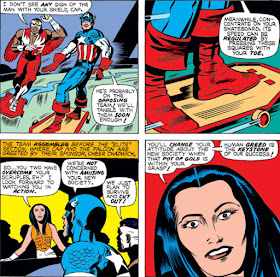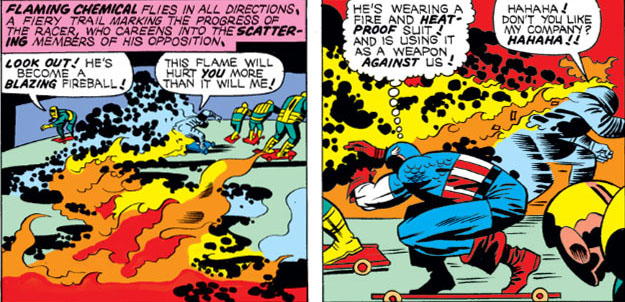With all the intrigue that writer/artist Jack Kirby sought to establish in his "madbomb" story in the pages of Captain America, there was a conflict which took place in two of those issues which cracked the door open and gave us a stark look at the secret society which wanted to basically throw out the U.S. Constitution--though once of its covers probably had a few of us wondering if this story hadn't gotten a little off-track.
Yet despite the ludicrous aspect of seeing Cap charging into battle on a skateboard, Kirby's interlude with this "Kill-Derby" is a fairly creative and certainly revealing way of demonstrating the inner workings of this new society--"a place of cruelty and cultism," as Kirby puts it, which Cap must investigate in order to find and destroy the madbomb which is set to go off at the nation's bicentennial celebration. What Cap and the Falcon have seen so far of this underground society has indicated a well-armed and well-organized militia and population; but, now captured, the two heroes are about to get a close-up look at what constitutes entertainment for the rabid masses waiting to claim the nation.
The more dramatic "Kill-Derby" designation is mainly referred to by Kirby, and only really used by name at its climax--instead called simply "the Derby" while the game is in play. The methods that are used by the "Elite" (those at the top tier of this society) to sell the masses on their vision of society take care of the rest, by encouraging the population to embrace greed and blood lust and surrender their freedom of choice. Here, the Elite need not force those in their society to enjoy killing--they simply let them see for themselves that there's nothing wrong with it, by packaging it in the guise of good sport which pulls out all the stops to entertain the spectators.
As for Cap, he's participating in this event in order to retrieve his shield, which was appropriated by one of the opposing team members. How borderline manic Cap becomes over the loss of his shield isn't exactly Kirby's finest hour as writer of this book; but at least Kirby provides ample backstory regarding the Derby itself, where two teams combat each other in order to gain a "pot of gold" as their reward. Before the Derby begins, the participants assemble before and are greeted by Cheer Chadwick, the daughter of a prominent member of the Elite--and Kirby begins to convey the sense that we're in the midst of a high-tech coliseum, where death awaits the losers.
Annnnndd, they're off! As opposed to the "roller derby" spectacle, however, these deadly teams charge at each other from opposite directions--and armed with weaponry. If you're motivated by greed, and you have a pot of gold waiting for you to claim it by whatever means necessary, your match isn't going to be based on scoring points--in this society, your goal is to eliminate your opposition, as ruthlessly as possible.
Cap makes a quick detour to free the Falcon from captivity, before making his way into the thick of things. Naturally, neither Cap nor the Falcon are following the rules of the Derby--their only concern is to secure Cap's shield and then move out to pursue the location of the madbomb. But the Derby has reached the point where it's mainly become one big brawl--and at close quarters, those who are interested in winning this match have the advantage of surprise over anyone who gets in their way. On the other hand, Cap has fought battle after battle in the thick of World War II, and here he even has air support.
So now it comes down to Cap vs. the dope who's hanging onto his shield and daring this flag-draped guy to take it away from him--all in front of the mesmerized, bloodthirsty crowd of onlookers who have a twisted concept of "team spirit."
We probably shouldn't hold our breath waiting for Cap's earnest words to sink into the minds of the crowd (and that goes double for their greedy "teammates")--mainly because, in Kirby's story, nobody in this society appears to have heard of Captain America. That's either a telling example of the Elite's methods of indoctrination, or a choice on Kirby's part to keep this underground society truly underground by making their way of life self-contained and a clear threat to the country. For the most part, the approach works, but Kirby misses a key opportunity for throwing an interesting spark into the story--namely, he creates a society that's committed to taking down the United States, yet he prevents it from engaging with Captain America, the living symbol of the country's ideals, except on the most basic level as an adversary who threatens their ascendancy. It's no wonder that things devolve again so quickly once the Derby concludes. By all indications, it's a society of violence that only knows what it wants, and not why it wants it--and without conviction, Kirby's tale can only be about the good guys vs. the bad guys.
Soon enough, the armed forces, which have been tracking Cap and the Falcon, burst in to clean out this "rat's nest"--and though the madbomb has eluded them, the search for it continues. From here, Cap's investigation leads to an encounter with Carol Harding, the daughter of the madbomb's inventor; but when we transition to this arc's conclusion, perhaps we'll learn more about the reasons behind this conspiracy--reasons that go beyond simply the desire to subvert democracy.
 | Captain America #s 196-197 Script and Pencils: Jack Kirby Inks: D. Bruce Berry and Frank Giacoia Letterers: D. Bruce Berry and John Costanza |
























I still have to pick up some of the Mad-Bomb chapters.., still quite jarring and unnerving after the glorious Englehart/Buscema soul-searching, comparatively-deeper CA&F tales.
ReplyDeleteBut all-in-all, looks to be an interesting read. And STILL far better than Robbins art.
While I consider the Madbomb epic something of a misfire, I am still one of those people who really enjoys Kirby's controversial run on Captain America. It could be for sentimental reasons, because it was my introduction to the character as a very young kid. But hey, it was the bi-centennial, and I had the T-shirt! And I've always loved the Kirby art.
ReplyDeleteThere were some great issues that came out of it, particularly the Arnim Zola arc. And we got to see Cap as a physically vulnerable guy who could have his hands full just fighting other guys and even lose to stronger opponents, instead of this unbeatable, super-powered fighting machine. I think they take a lot away from characters when they make them invincible, like the Hulk or Wolverine. I think there's been too much of it.
M.P.
M.P., you'll get no argument from me on reining in the invulnerability of the likes of Wolverine and the Hulk. Why should it matter if their foe critically injures them? They'll be on their feet again in no time, essentially wiping the slate clean of whatever drama the reader felt at seeing them fall--while to them, that broken leg or javelin through the heart was a minor nuisance that only pissed them off.
ReplyDelete